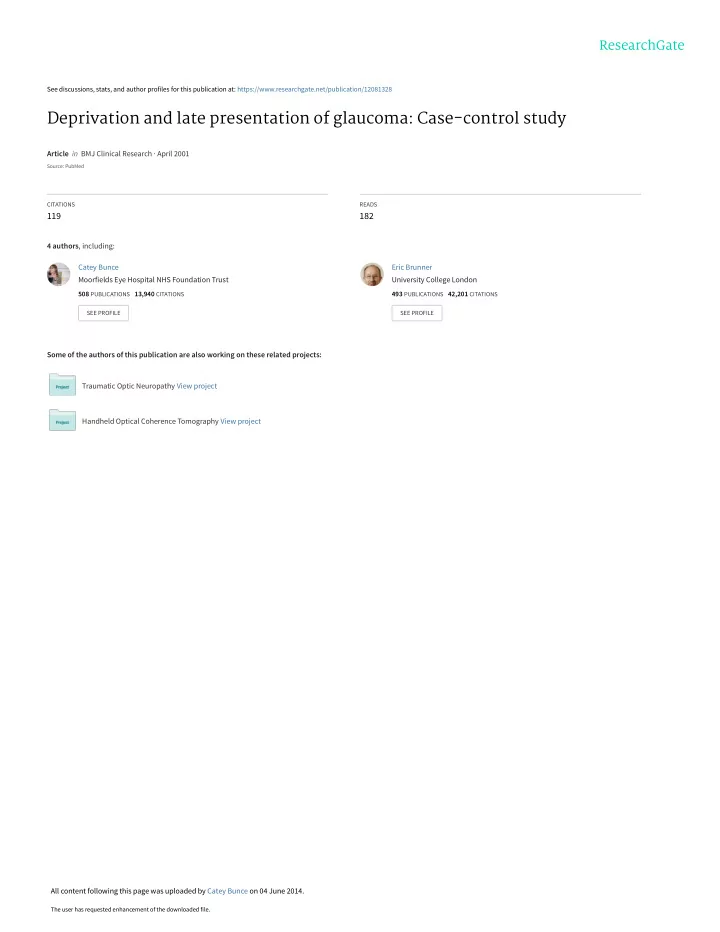

See discussions, stats, and author profiles for this publication at: https://www.researchgate.net/publication/12081328 Deprivation and late presentation of glaucoma: Case-control study Article in BMJ Clinical Research · April 2001 Source: PubMed CITATIONS READS 119 182 4 authors , including: Catey Bunce Eric Brunner Moorfields Eye Hospital NHS Foundation Trust University College London 508 PUBLICATIONS 13,940 CITATIONS 493 PUBLICATIONS 42,201 CITATIONS SEE PROFILE SEE PROFILE Some of the authors of this publication are also working on these related projects: Traumatic Optic Neuropathy View project Handheld Optical Coherence Tomography View project All content following this page was uploaded by Catey Bunce on 04 June 2014. The user has requested enhancement of the downloaded file.
Papers Deprivation and late presentation of glaucoma: case-control study Scott Fraser, Catey Bunce, Richard Wormald, Eric Brunner Abstract End stage glaucoma causes a particularly profound Glaxo Department of Ophthalmic and irreversible visual loss, but population studies Epidemiology, Objective To identify socioeconomic risk factors for show that only half of glaucoma sufferers are Institute of first presentation advanced glaucomatous visual field 5 Late presenta- Ophthalmology, diagnosed and treated at any one time. loss. University College tion, when visual field loss threatens central vision, is an London, London Design Hospital based case-control study with important risk factor for blindness related to EC1V 2PD prospective identification of patients. 6 Research into determinants of presenta- glaucoma. Scott Fraser Setting Three hospital eye departments. clinical research fellow tion with advanced glaucoma is scarce. We therefore Participants Consecutive patients newly diagnosed Catey Bunce designed this case-control study to determine both medical statistician with glaucoma (n = 220). Cases (late presenters) were social and demographic risk factors as well as ocular Richard Wormald those presenting with advanced glaucoma (n = 110), and biological factors (presented elsewhere 7 ). We director controls were those with early glaucoma (n = 110). report on the role of area deprivation and several International Results Median underprivileged area scores were Centre for Health measures of individual socioeconomic status in the higher among late presenters (29.5; interquartile and Society, stage of presentation with glaucoma in the hospital eye Department of range 9.0-42.2) than in the control group (21.3; service. A link between deprivation and advanced glau- Epidemiology and 6.1-37.4) (P = 0.035). Late presenters were more likely Public Health, comatous visual field loss at first presentation would to be of lower occupational class (odds ratio adjusted University College provide evidence for systematic inequity of access to London, London for age and referral centre 20.1 (95% confidence 8 effective hospital care. WC1E 6BT interval 2.6 to 155) for group III compared with Eric Brunner group I-II and 86.0 (11.0 to 673 for group IV-V senior lecturer Methods compared with group I-II), to have no access to a car Correspondence to: R Wormald (2.2; 1.2 to 4.0), to have left full time education at age We carried out a prospective hospital based case- r.wormald@ 14 or less (7.5; 2.3 to 24.7), and to be tenants rather control study with recruitment at three independent ucl.ac.uk than owner occupiers (local authority tenants 3.2; 1.7 eye departments in England (Moorfields Eye Hospital, to 5.8, private tenants 2.1; 0.7 to 5.8). Effects of London; Sunderland Eye Infirmary, Sunderland; BMJ 2001;322:639–43 deprivation were partly accounted for by family Harold Wood Hospital, Essex) between September history of glaucoma, time since last visit to an 1996 and May 1997. Participants were eligible for study optometrist, and lack of an initial diagnosis of if they were diagnosed with glaucoma according to the glaucoma by an optometrist. case-control criteria described in the box when they Conclusions Area and individual level deprivation were first examined by the ophthalmologist. Those were both associated with late presentation of with a previous definite or possible diagnosis of glaucoma. Existing evidence shows that late glaucoma or ocular hypertension were not eligible. presentation is an important risk factor for The optic disc criteria were shown, by a pilot study, to 9 Intraocular subsequent blindness. Deprived groups thus seem to be good indicators of severity of disease. be at greater risk of going blind from glaucoma. pressure was obtained from the standard Goldmann Material deprivation may be associated with more tonometer reading at initial examination. We calcu- aggressive disease as well as later presentation. lated that we needed 110 cases and 110 controls to provide 79% power to detect a threefold increase in the odds of late presentation in a factor present among Introduction 10% of the control group at the 5% level of significance Glaucoma is a disease with major importance in public (two tailed test). health and accounts for 13% of all new registrations of Patients were excluded if they had problems 1 It affects about 2% of Europeans blindness annually. performing the visual field test. This was defined as aged 40 and over and some four times this proportion having more than one third fixation losses or one third 2 The in African-Americans and African-Caribbeans. false positive or one third false negative responses for European and US populations are ageing, and as glaucoma on visual field analysis. 3 4 prevalence of glaucoma is strongly linked with age We conducted the study prospectively to reduce the number of people blinded by the disease is set to selection and recall bias. Recruitment after the first of two visual field tests gave a consecutive series of cases increase. 639 BMJ VOLUME 322 17 MARCH 2001 bmj.com
Recommend
More recommend